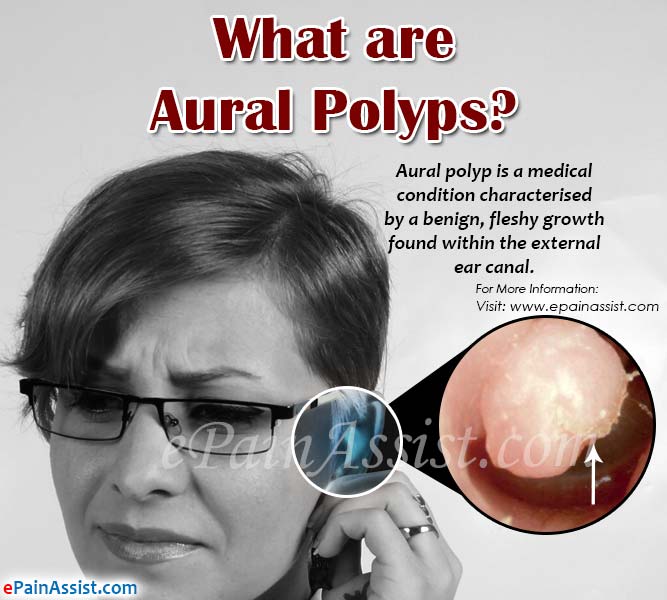Aural polyp is a medical condition characterised by a benign, fleshy growth found within the external ear canal. It is also known as ear polyps or otic polyps. It is an abnormal growth seen in the external ear or the middle ear and it may be attached to the ear drum or the tympanic membrane. It is a condition that can affect any group without any gender predisposition. It has been noted that people who are susceptible to chronic ear infection associated with inflammation are more prone to aural polyps than others. This condition is usually associated with blood stained ear discharge with ear aches. Aural polyp is diagnosed on close physical examination and the treatment plan depends on the cause and extent of the polyp.

Signs and Symptoms of Aural Polyps
The most common symptoms of aural polyps are as follows:
- Large amount of ear discharge which may be associated with blood discharge
- Fullness or pressure build up in ears
- Severe ear ache and extreme ear discomfort
- Hearing deficiency.
Epidemiology of Aural Polyps
Aural polyp can affect all age or sex. It can affect any individual irrespective of the age or sex of the individual. It affects all races and ethnicities equally. It is known to occur worldwide; however, the incidence is more among the developing countries.
Causes of Aural Polyps
Aural polyp may be caused by multiple reasons. The most common causes of aural polyp are mentioned below:
- Presence of ear infections or inflammatory condition of the ears (acute or chronic)
- Underlying conditions such as cholesteatoma, i.e. presence of a benign growth of squamous epithelium in the middle ear
- Presence of foreign objects within the ear or within close contact causing irritation over the skin in the ear
- Benign or malignant tumors in the ears.
Risk Factors of Aural Polyps
Aural polyp is associated with risk factors or predisposing factors such as:
- Chronic ear infection
- Chronic ear irritation
- Chronic inflammatory diseases which includes certain auto-immune disorders
It is not necessary that the presence of the above mentioned condition will definitely lead to aural polyps; however, the presence of these condition increases the risk and likelihood of acquiring aural polyp.
Complications of Aural Polyps
Aural polyp, if left untreated, can lead to serious complications. The possible complications of aural polyps include:
- Development of cholesteatoma associate with expanding abnormal growth in the middle ear
- Hearing deficiency
- Development of cancerous condition.
Prognosis of Aural Polyps
The prognosis of aural polyps largely depends of the cause of the polyp. With appropriate treatment and care, the prognosis of aural polyp is usually good. If the polyp is caused due to presence of a cholesteatoma, this condition can lead to permanent damage in the middle ear. If the polyp is secondary to chronic ear infection, there is a possibility of recurrence of aural polyps. It has been noticed that if the underlying cause of the polyp has been resolved completely and the polyps recedes completely, the condition does not have any long term ill effects.
Diagnosis of Aural Polyps
Aural polyp is diagnosed and treated by an ENT specialist or an otolaryngologist. It is advised to follow up with an experienced physician at the earliest to rule out any possibility of malignancy. A detailed case history is obtained followed by physical examination of the ears. Physical examination involves otoscopy, where a specialized device known as otoscope is used to examine the ears. In addition, investigatory tests may be done for further evaluation and management. These tests include pathological tests or laboratory test of the ear discharge collected with a swab. Biopsy is done to rule out malignancy; i.e. chances of being cancerous.
Treatment of Aural Polyps
The treatment modality of aural polyps depend on the extent and severity of the condition. In most of the cases, antibiotic ear drops are prescribed based on the causative agent. In some cases, steroids may be prescribed. Precautions are taken to avoid exposure of the affected ear to water as this worsens the condition. In severe cases, if antibiotics and steroids do not provide improvement in the condition, surgical intervention is considered. The abnormal growth is surgically excised. In some cases, radiation therapy or laser surgery is considered. In case of aural polyp associated with cholesteatoma, surgical correction is the choice of treatment.
Conclusion
Aural polyp (also known as otic polyp or ear polyp) is an abnormal growth seen outside the ear or within the middle ear. It is generally caused by presence of chronic ear infection, inflammation or irritation. Treatment modalities include antibiotic therapy and steroid therapy. In extreme cases surgery may be considered. If left untreated, aural polyps can lead to serious complications which include permanent hearing loss and malignancies.
- American Academy of Otolaryngology–Head and Neck Surgery. “Ear Infections.” (URL: https://www.enthealth.org/conditions/ear-infections/)
- Mayo Clinic. “Ear Infections (Otitis Media).” (URL: https://www.mayoclinic.org/diseases-conditions/ear-infections/symptoms-causes/syc-20351616)
- Cleveland Clinic. “Cholesteatoma.” (URL: https://my.clevelandclinic.org/health/diseases/15248-cholesteatoma)
- American Academy of Otolaryngology–Head and Neck Surgery. “Cholesteatoma.” (URL: https://www.entnet.org/cholesteatoma/)
- WebMD. “Otitis Media (Middle Ear Infection) in Adults.” (URL: https://www.webmd.com/cold-and-flu/ear-infection/middle-ear-infections-in-adults)
